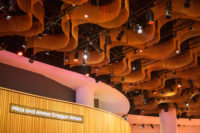Godella, Spain
With his design for the Atrium House, 36-year-old architect Fran Silvestre takes a fresh look at 20th-century Modernist formulas, from the courtyard houses of Mies van der Rohe of the 1920s and '30s to the Case Study Houses in Los Angeles of the 1950s and '60s. In the process, he offers nods to 'lvaro Siza, for whom he worked for two years (2001'03), and Eduardo Souto de Moura, who spent five years in Siza's office. The house'located outside Valencia, Spain'wraps around two sides of a sprawling white Ibiza-marble terrace (the 'atrium' of its name), with Leylandii-cypress hedges serving as a contrasting natural enclosure on its other two sides and completing the courtyard.
The layout of the house can be taken in at a glance: a continuous wall of floor-to-ceiling glass reveals a 57-foot- long wing for the living area on one side and a bedroom wing on the other. 'My strategy was to free the largest possible area for the pleasure of a private outdoor space with limitless height and volume,' Silvestre explains. 'I see the house and its site as a continuum.'
The uninterrupted sweep of glass is made possible by a structure of high-strength concrete walls and slabs. The entire roof of the living area, with the glass wall on one side and a trench skylight running along the ceiling on the other, is supported at only three points, including a pair of steel columns hidden inside a built-in maple cabinet between the dining and sitting areas. The sliding panels of the long glass wall also push the limits of structural feasibility, thanks to a Swiss framing system that reduces their aluminum profiles to just ' of an inch.
Silvestre dramatically choreographs the entry sequence, bringing visitors into the house on the upper level, along the long, windowless back wall of the living area to the front door, located at the intersection of the two wings. This promenade perches above a long patio one level below that provides natural light to spaces such as a study and guest room. On the rear, northern exposure of the upper level, the bedrooms and kitchen look through a continuous curtain wall into a small enclosed garden. Concrete walls in this wing, along with the floor and ceiling, form a three-dimensional truss that spans a four-car garage below. Designed for a couple currently without children, the three-bedroom program includes room for the family to grow.
Inside the house, an austere formality reigns, as Silvestre wrestled with every detail to eliminate any extraneous element. In the process, he devised frameless floor-to-ceiling doors; electrical outlets that drop down from kitchen cabinets to keep them out of view; a mechanism that hides the microwave oven in a cabinet when not in use; and fold-away mirrors in the master bathrooms that open out over the back window wall only when needed. Even outside, he avoided visible plumbing by devising a trick shower on the terrace by the pool that shoots water upward from the ground when bathers step on its plate. While these details are fun, other design decisions could be accused of sacrificing livability. In the bedroom wing, the master bedroom lacks privacy and bathrooms occupy a disproportionate amount of space. And all the glaring white marble and glass has prompted the owners to add extra shading elements to protect the house from Valencia's fierce summer climate.
The overall effect of the house's uninterrupted surfaces is to focus attention on people, furnishings, and outdoor views. The owners' collection of large, colorful paintings by local artist Juan Ripoll's helps anchor the living spaces and adds warmth, as does the Italian furniture selected by interior designer Andr's Alfaro Hofmann.
Following his graduation from the Polytechnic University of Valencia, Silvestre collaborated on a number of private houses with Alfaro Hofmann, the son of Andreu Alfaro, a renowned local sculptor. The sculptural impulse evident in Silvestre's work and his drive to overcome the limits of materiality in favor of formal expression reflect the influence of the elder Alfaro. Traces of Siza's formal vocabulary are evident too in the white surfaces, overhanging planes, and elongated horizontal lines of the house. But in Siza's work, a door is always a door and a window a window; he never treats them as obstacles to overcome.
In this respect, Silvestre's approach may be closer to that of Siza's disciple Souto de Moura in his early court houses in Porto, Portugal. Silvestre, though, replaces the solid, walled enclosures of Souto de Moura's courtyards with glass, vegetation, and floating horizontal planes. His Atrium House is a work at ease in nature and the outdoors. With its 50-foot-long lap pool and elegant white marble, it's the incarnation of an enduring Mediterranean ideal.
Completion Date: March 2010
Size: 12,375 square feet (gross)
Total construction cost: $1.75 million
Architect:
Fran Silvestre Arquitectos
Calle San Vicente Mártir 160, 1 · 46007
Valencia, Spain
Phone: +34 963 816 561
info@fransilvestrearquitectos.com
PeopleOwner: withheld
Architect
Personnel in architect's firm who should receive special credit:
Engineer(s):
Consultant(s):
Collaborators Lighting: STUDIO2 General contractor: COARCO
Photographer(s):
Photo with furniture:
Renderer(s): |
Products
Structural system Foundation: Continuous spread footing.
Exterior cladding
Roofing
Windows
Glazing
Doors
Hardware
Interior finishes
Surfaces: Interiors | Plasterwork Suspended ceiling: Smooth plasterboard panels Paint: Matt plastic paint RAL 9016
Furnishings
Furniture: Interior | Sofa Hamilton, Minotti
Dinner table Serra and chairs Manet, Minotti.
Sanitaryware
Lighting Light Fittings: LS 990 Series, Jung |











